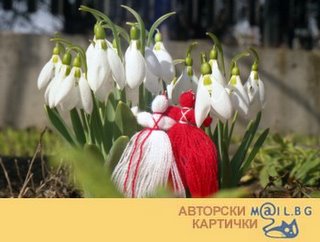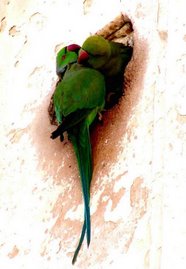


The Martenitsa Day!
If you are fortunate enough to visit Plovdiv, Sofia,Varna (or anywhere else in Bulgaria) on the first of March you are certain to notice almost every person decorated with small tokens made from red and white woollen threads. Then from late March to mid-April, you will notice many fruit trees and shrubs decorated with these same tokens. March 1 is the "Baba Marta" day in Bulgaria - on the first of March, and the days following, all people give to each other red-and-white strips or small woollen dolls called Pizho (the male character) and Penda (the female one), also known as Martenitzi. They are so named because they bring the name of March, or in Bulgarian - Mart. According to tradition, Marta (the female variation of the word ?Mart?) is an angry old lady who rapidly changes her mood from bad to good and back again. She is popular all around as Grandmother Marta
(in Bulgarian "Baba Marta").
There are many beliefs and stories regarding the meaning of the red-and-white symbols of the Martenitsas ? the most popular being the following one:
More than a dozen centuries ago, the proto-Bulgarian ruler Khan Asparukh (also known as Isperikh) left his home in the distant Tibet Mountains in search of fertile land for his people to live on. He passed through many rivers and mountains until he finally reached the lands of the Slavs, who greeted him and his people as dear guests. Slav women, wearing white outfits brought drinks, while the tables were full of foods ? everything that grows on that blessed land. But the Khan was sad and homesick and he missed his mother and his dear sister Kalina. He sat by the huge river and tears ran down hid sunburnt face, while he prayed to gods and the sun for a miracle to happen. And it did happen! A swallow landed on his shoulder and the Khan shared all his sorrow to her. Then the swallow flew away, back to the lands the proto-Bulgarians came from, and with a human voice it told Kalina, the Khan?s sister, that her brother found a new land for his kingdom but he is misses her so much and sends his best feelings?
Kalina was so happy to hear that ? and she decided to send her brother a token that she had got the news. She made a small bunch from some green bush, she bound it with a white woollen thread, and made knots at the end of the thread as a greeting sign ? and she sent the swallow to take that bunch back to her brother. The swallow flew fast as lightning and very soon it landed on the Khan?s shoulder again. But due to the long flight his wing was hurt and some blood drops dyed the white woollen thread. The Khan was so happy to see the green bunch, he got his sister?s greeting by the knots she had made, and so he pinned the bunch on his chest. The Khan ordered his men each to put a small bunch of twisted red-and-white thread on that day each year ? for health and heavenly blessing. That happened on the first of March and remained as a tradition ever since.
As the Bulgarian tradition goes, each morning on the first of March, a fire has to be started in the yard, with plenty of smoke. Then everyone living in the house jumps over the fire three times, facing the rising sun, to clean off any evil spirits and keep away all illnesses. Then the mistress of the house takes out some red clothes and fabrics and flings them on tree-branches and on the fence. Then she decorates the young kids and the newborn animals with Martenitzas she prepared herself from woollen or cotton threads.
The traditional Bulgarian Martenitzas had various additional objects, woven into them ? coins, dry garlic cloves, blue beads, iron rings, hairs of horse?s tail, snails? shells ? therefore people always believed the Martenitzas to be special kinds of tokens, keeping all the evil spirits away. According to oldest traditions, children are supposed to carry the Martenitzas on their right wrist, on the neck (as a necklace) or on their chest, while the young unmarried or the newly wed women ? on their neck or woven into their hair. Men are allowed to carry their Martenitzas over their left elbow or over their left ankle (i.e. to remain unseen!), while in some regions they put them into their left shoes, under the heel ? due to the belief that if someone saw them with a martenitza tied on their wrist, then their masculinity could be tied too...
The traditions and beliefs remained all through the centuries, although today Bulgarians also wear the red-and-white tokens with the belief to please Baba Marta - so she will not make us cold. In doing so, we are expressing the hope that the warm spring will come as soon as possible. Once we have our martenitzas, which we pin on our clothing or wear tied on our wrists (it is usually the right wrist we put the martenitzas on), we keep them until we see some sign of spring - such as a stork, crane or swallow, or a blossoming tree. Only after seeing that sign do we remove the martenitzas, because then we know that spring has truly arrived. In different parts of the country, however, the belief differs somewhat. After seeing a stork, most will tie their Martenitzas on a fruit tree, and they make a wish, which is believed to always happen!



4 коментара:
Wow! that's very interesting :)
thank dear Ancient....i will give u one someday...
H-Birthday. and Martenitsa, i have one ..it's one year old now ;-)
wow
heheh next time i will send you 12 so you can change them every moth...
Публикуване на коментар